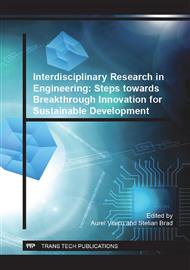[1]
I.A. Burchitz, Improvement of Springback Prediction in Sheet Metal Forming, Ph. D thesis, Rotterdam, 2008, p.19.
Google Scholar
[2]
M. Samuel, Experimental and numerical prediction of springback and side wall curl in U-bendings of anisotropic sheet metals, Journal of Materials Processing Technology 105 (2000) 382-393.
DOI: 10.1016/s0924-0136(00)00587-2
Google Scholar
[3]
C. Gomes, O. Onipede, M. Lovell, Investigation of springback in high strength anisotropic steels, Journal of Materials Processing Technology 159 (2005) 91–98.
DOI: 10.1016/j.jmatprotec.2004.04.423
Google Scholar
[4]
Y.H. Moon, S. S Kang, J. R Cho, T. G Kim, Effect of tool temperature on the reduction of the springback of aluminum sheets, Journal of Materials Processing Technology 132 (2003) 365-368.
DOI: 10.1016/s0924-0136(02)00925-1
Google Scholar
[5]
M.L. Garcia-Romeu, J. Ciurana, I. Ferrer, Springback determination of sheet metals in an air bending process based on an experimental work, Journal of Materials Processing Technology 191 (2007) 174-177.
DOI: 10.1016/j.jmatprotec.2007.03.019
Google Scholar
[6]
J.R. Cho, S.J. Moon, Y.H. Moon, S.S. Kang, Finite element investigation on springback characteristics in sheet metal U-bending process, Journal of Materials Processing Technology 141(1) (2003) 109–116.
DOI: 10.1016/s0924-0136(03)00163-8
Google Scholar
[7]
T. Hama, T. Nagata, C. Teodosiu, A. Makinouchi, H. Takuda, Finite-element simulation of springback in sheet metal forming using local interpolation for tool surfaces, International Journal of Mechanical Sciences 50 (2008) 175–192.
DOI: 10.1016/j.ijmecsci.2007.07.005
Google Scholar
[8]
S.K. Panthi, N. Ramakrishnan, M. Ahmed, S.S. Singh, M.D. Goel, Finite Element Analysis of sheet metal bending process to predict the springback, Materials and Design 31 (2010) 657–662.
DOI: 10.1016/j.matdes.2009.08.022
Google Scholar
[9]
L.P. Lei, S.M. Hwang, B.S. Kang, Finite element analysis and design in stainless steel sheet forming and its experimental comparison, Journal of Materials Processing Technology 110 (2001) 70–77.
DOI: 10.1016/s0924-0136(00)00735-4
Google Scholar
[10]
K. Yilamu, R. Hino, H. Hamasaki, F. Yoshida, Air bending and springback of stainless steel clad aluminum sheet, Journal of Materials Processing Technology 210 (2010) 272–278.
DOI: 10.1016/j.jmatprotec.2009.09.010
Google Scholar
[11]
D. Zhang, Z. Cui, X. Ruan, Y. Li, An analytical model for predicting springback and side wall curl of sheet after U-bending, Computational Materials Science 38(4) (2007) 707–715.
DOI: 10.1016/j.commatsci.2006.05.001
Google Scholar
[12]
H. Liu, Z. Xing, Z. Sun, J. Bao, Adaptive multiple scale meshless simulation on springback analysis in sheet metal forming, Engineering Analysis with Boundary Elements 35 (2011) 436–451.
DOI: 10.1016/j.enganabound.2010.06.025
Google Scholar
[13]
X. Li, Y. Yang, Y. Wang, J. Bao, S.P. Li, Effect of the material hardening mode on the springback simulation accuracy of V-free bending, Journal of Materials Processing Technology 123 (2002) 209–211.
DOI: 10.1016/s0924-0136(02)00055-9
Google Scholar
[14]
S. Chatti, N. Hermi, The effect of non-linear recovery on springback prediction, Computers and Structures 89 (2011) 1367–1377.
DOI: 10.1016/j.compstruc.2011.03.010
Google Scholar
[15]
H. Baseri, M. Bakhshi-Jooybari, B. Rahmani, Modeling of Spring-back in V-die Bending Process by Using Fuzzy Learning Back-propagation Algorithm, Expert Systems with Applications 38 (2011) 8894–8900.
DOI: 10.1016/j.eswa.2011.01.102
Google Scholar
[16]
V. Nasrollahi, B. Arezoo, Prediction of springback in sheet metal components with holes on the bending area, using experiments, finite element and neural networks, Materials and Design 36 (2012) 331–336.
DOI: 10.1016/j.matdes.2011.11.039
Google Scholar
[17]
W. Liu, Q. Liu, F. Ruan, Z. Liang, H. Qiu, Springback prediction for sheet metal forming based on GA–ANN technology, Journal of Materials Processing Technology 187–188 (2007) 227–231.
DOI: 10.1016/j.jmatprotec.2006.11.087
Google Scholar
[18]
L. Wei, Y. Yuying, X. Zhongwen, Z. Lihong, Springback control of sheet metal forming based on the response-surface method and multi-objective genetic algorithm, Materials Science and Engineering A 499 (2009) 325–328.
DOI: 10.1016/j.msea.2007.11.121
Google Scholar
[19]
C. Jiang, X. Han, G.R. Liu, G.Y. Li, The optimization of the variable binder force in U-shaped forming with uncertain friction coefficient, Journal of Materials Processing Technology 182 (2007) 262–267.
DOI: 10.1016/j.jmatprotec.2006.08.002
Google Scholar
[20]
Y. Ledoux, P. Sébastian, S. Samper, Optimization method for stamping tools under reliability constraints using genetic algorithms and finite element simulations, Journal of Materials Processing Technology 210 (2010) 474–486.
DOI: 10.1016/j.jmatprotec.2009.10.010
Google Scholar
[21]
Z. Fu, J. Mo, L. Chen, W. Chen, Using genetic algorithm-back propagation neural network prediction and finite-element model simulation to optimize the process of multiple-step incremental air-bending forming of sheet metal, Materials and Design 31 (2010).
DOI: 10.1016/j.matdes.2009.06.019
Google Scholar
[22]
A. Forcellese, F. Gabriella, Artificial neural-network-based control system for springback compensation press-brake forming, International Journal of Materials and Production Technology 16 (2001) 545–563.
DOI: 10.1504/ijmpt.2001.001280
Google Scholar
[23]
D.A. Smith, Die Design Handbook, third ed., Society of Manufacturing Engineers, (1996).
Google Scholar
[24]
J.S.R. Jang, Anfis: adaptive-network-based fuzzy inference system, IEEE Transactions on Systems, Man, and Cybernetics 23 (1993) 665–685.
DOI: 10.1109/21.256541
Google Scholar
[25]
J.S.R. Jang, C.T. Sun, E. Mizutani, Neuro-Fuzzy and Soft Computing, Prentice-Hall, 1997, p.614.
Google Scholar
[26]
T. Takagi, M. Sugeno, Derivation of fuzzy control rules from human operator's control actions, Proceedings of the IFAC Symposium on Fuzzy Information, Knowledge Representation and Decision Analysis (1983) 55-60.
DOI: 10.1016/s1474-6670(17)62005-6
Google Scholar


